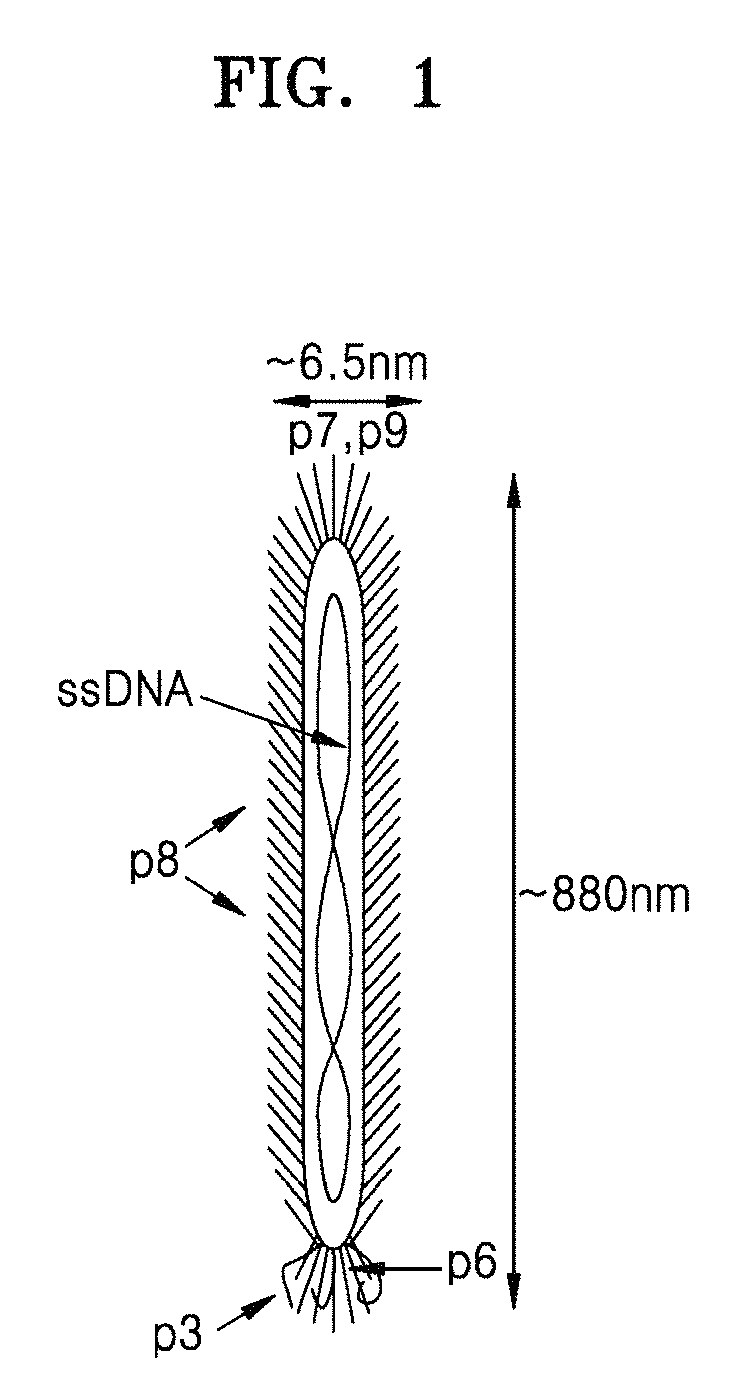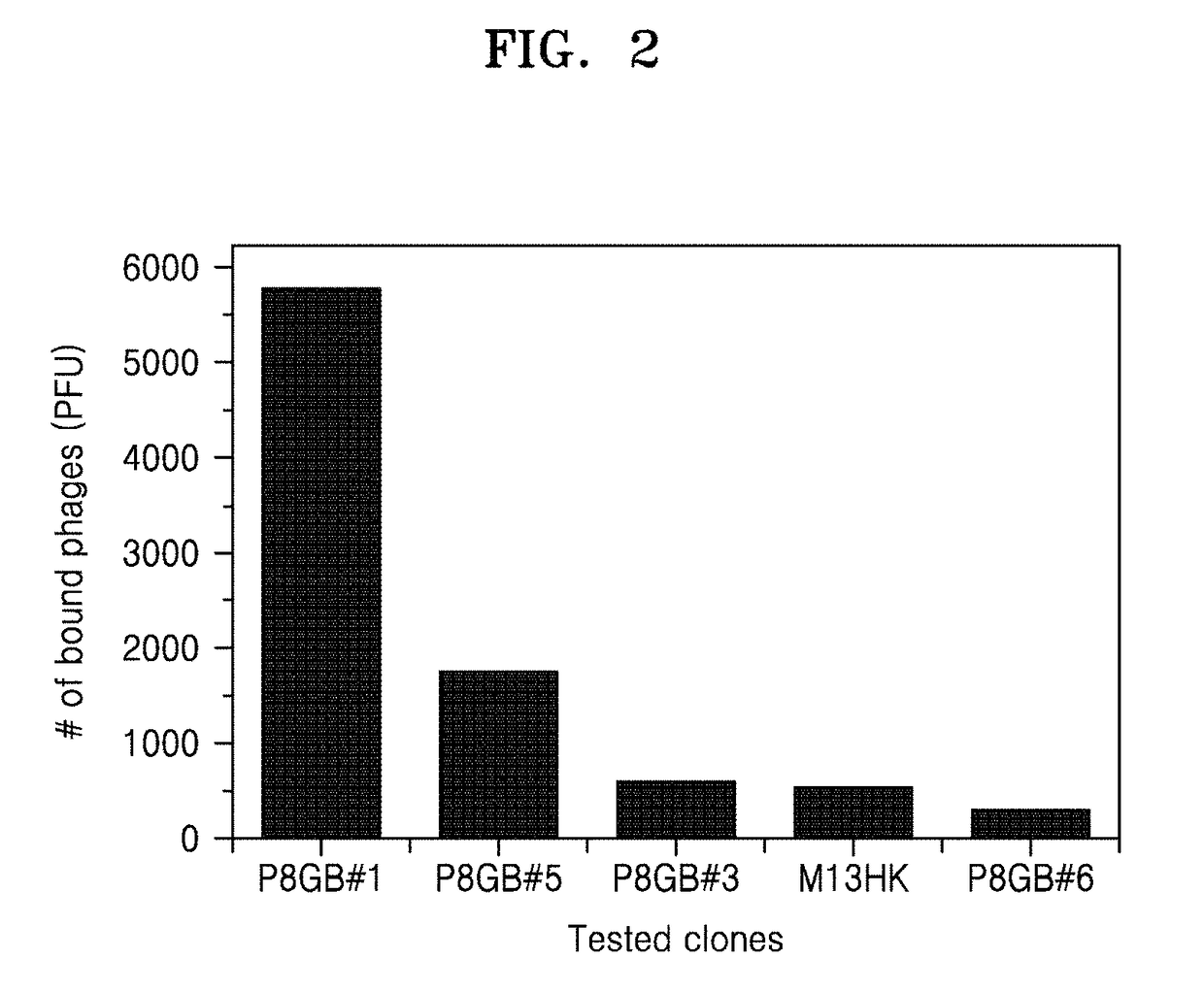Peptide selectively binding to graphitic materials and volatile organic compounds
a graphitic material and volatile organic compound technology, applied in the field of new materials, can solve the problems of inability to achieve synergic effect between peptides, deterioration of the intrinsic properties of low-dimensional carbon materials such as high electrical conductivity, and limited application, and achieve excellent selectivity for volatile organic compounds, excellent binding affinity of specifically binding, and stable at room temperature
- Summary
- Abstract
- Description
- Claims
- Application Information
AI Technical Summary
Benefits of technology
Problems solved by technology
Method used
Image
Examples
example 1
of Peptides Selectively Binding to Graphitic Materials
[0080]1. Preparation of M13 Phage-Display p8 Peptide Library
[0081]An M13 phage-display p8 peptide library is prepared in order to select peptides selectively binding to graphitic materials.
[0082]First, an M13HK vector is prepared using oligonucleotides of SEQ ID NOs: 10 and 11 for site-directed mutation of the 1381st base pair C of an M13KE vector (NEB, product#N0316S) (SEQ ID NO: 9) to G. The prepared M13HK vector is double-digested using restriction enzymes, BspHI (NEB, product# R0517S) and BamHI (NEB, product#R3136T), and dephosphorylated using antarctic phosphatase. The dephosphorylated vector is ligated to a double-digested DNA duplex by incubation at 16° C. overnight. A product is then purified and concentrated. Electorcompetent cells (XL-1 Blue, Stratagene) are transformed with 2 μl of a concentrated ligated vector solution by electroporation at 18 kV / cml. A total of five transformations are performed for the library const...
example 2
on of Graphitic Material Bound with Peptide-Displaying M13 Phage
[0103]1. Preparation of Graphene Bound with Peptide-Displaying M13 Phage
[0104]Graphene, on which the M13 phage displaying the peptide of SEQ ID NO: 1 according to an embodiment of the present disclosure is arranged, is prepared.
[0105]First, an M13 phage including the peptide sequence p8 GB#1 (SEQ ID NO: 5) is prepared using the biopanning method used in Example 1. Considering that the distance between phages may increase at higher pH because of increased electrostatic repulsion between the phages, a phage solution having a concentration of 1×1013 viral particles / ml is prepared using ultrapure distilled water adjusted to pH 7.0. The concentration of the phage solution may be calculated by the following Equation 1.
Phage concentration(viral particles / mL)=1.6×1016×O.D. viral solution / 7237[Equation 1]
[0106]Then, graphene (product name: kish graphite, manufacturer: Covalent) is placed on a SiO2 / Si substrate (product name: EPI...
example 3
inding Affinity to Volatile Organic Compounds
[0127]In order to examine whether the peptides selected in Example 1, GP1 (SEQ ID NO: 3) and GP2 (SEQ ID NO: 4) selectively react with volatile organic compounds, binding affinity is tested in liquid phase and gas phase.
[0128]1. Test of Binding Affinity to Benzene
[0129]First, a substrate having a benzene-immobilized HOPG surface is treated with GP1 or GP2-displaying phage, and the number (PFU) of the phage bound with benzene is counted, and the result is shown in FIG. 9A.
[0130]Next, a microcantilever system is used for gas phase sensing. The cantilever system consists of four compartments, with each compartment including three cantilevers. Separate compartment enables independent functionalization of the cantilevers. Cantilevers in the fourth compartment are used as references. For peptide immobilization, Cr (10 nm) / Au (50 nm) layers are deposited onto the microcantilevers. The surface is cleaned in piranha solution (4:1 ratio of H2SO4 (9...
PUM
| Property | Measurement | Unit |
|---|---|---|
| area | aaaaa | aaaaa |
| thickness | aaaaa | aaaaa |
| diameter | aaaaa | aaaaa |
Abstract
Description
Claims
Application Information
 Login to View More
Login to View More - R&D
- Intellectual Property
- Life Sciences
- Materials
- Tech Scout
- Unparalleled Data Quality
- Higher Quality Content
- 60% Fewer Hallucinations
Browse by: Latest US Patents, China's latest patents, Technical Efficacy Thesaurus, Application Domain, Technology Topic, Popular Technical Reports.
© 2025 PatSnap. All rights reserved.Legal|Privacy policy|Modern Slavery Act Transparency Statement|Sitemap|About US| Contact US: help@patsnap.com



